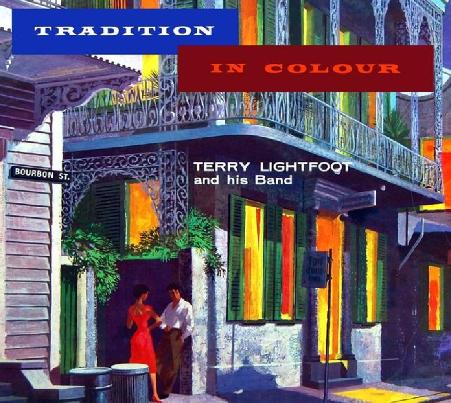
Editor, Webmaster: Phil Cartwright
Editor@earlyjas.org
Editor@earlyjas.org
|
| Earlville Association for Ragtime Lovers Yearning for Jazz Advancement and Socialization |
EARLYJAS
The British Trad Jazz movement of the 1950s and ‘60s, when acknowledged by
jazz historians at all, is generally footnoted among the various revivals of early
New Orleans style, beginning with Bechet’s Blue Note recordings and the various
renewals of interest driven by Louis Armstrong’s extended career. While there is
certainly truth to this categorization, such a pigeon hole can also be misleading and
devaluing when we really consider the achievement of the actual music: “Creative
Resurgence” would be my choice as a better way of understanding what actually
happened. Of the many masterful, and deceptively innovative, albums to be
released in a very short period of time, Terry Lightfoot’s Tradition in Colour
remains a strong example.
The title of each tune makes a nod to the visible spectrum, and leading off with
“Green for Danger” we’re thrown right into the Trad Jazz aesthetic—more modal
and streamlined than most revival jazz, Wayne Chandler’s banjo standing out more
prominently as an organizational influence, the drums (played by a young Ginger
Baker) taking a less dominant, more timbral role. Lightfoot’s clarinet, from
beginning to end of the album, is excellent—rich, powerful in all registers, layered,
Edmond Hall seem evident, but any and all role models have been fully integrated
into a new voice in the jazz clarinet world—confident, relaxed, commanding
without being overbearing, ruminative (especially on his salute to George Lewis in
“Burgundy Street Blues”).
While Lightfoot is the focus, taking the spotlight on the majority of solo numbers,
he gives Colin Smith a chance to show off his strong trumpet in Fats Waller’s
“Blue Turning Grey Over You.” Later in the album, he features John Bennett’s
trombone on “My Blue Heaven.” Bennett in particular seems to have a sound
indebted to the English Brass Band tradition, unique in wind playing for its mellow,
round, shimmering quality. This is one of the great treats of British Trad Jazz, by
the way: the British brass tradition is less buzzy and directional than many others,
and the warmth that they bring can change the repertoire immediately, offering
different angles on each tune.
Terry Lightfoot himself, however, must be singled out for high praise. His soloing
style, while owing a debt to American forefathers, is likewise a product of a
specifically British style of clarinetistry, fused to the New Orleans tradition. The
richness of his chalumeau, which seamlessly glides into the clarion register, is
unique. He is less impetuous and more methodical in his soloing ideas, opting to
use motivic cells throughout distinct choruses. That type of playing, more
emotionally circumspect, would seem to be antithetical to blues playing, but in
Lightfoot’s case it is not: He impresses by being ruminative and contemplative
rather than disengaged or cerebral. His blues are deep and strong, even in their
detached quality. Most gratifying is that he managed to play the full rich New
Orleans style chalumeau without falling into the trap of so many revival
clarinetists—going flat. Lightfoot’s execution of the music and the clarinet itself are
therefore of importance.
Unfortunately, “Orange Blossom”, is attributed to Lightfoot himself (at least on the
edition of the album I own), yet is unmistakably a George Lewis original, “St.
Philip Street Breakdown.” Unless this is a misprint, it can only be considered
embarrassing that the attribution was not acknowledged, marring an otherwise
fascinating album.
Terry Lightfoot and His Band: Tradition in Colour,
EMI (Encore! ENC 124), 1958
